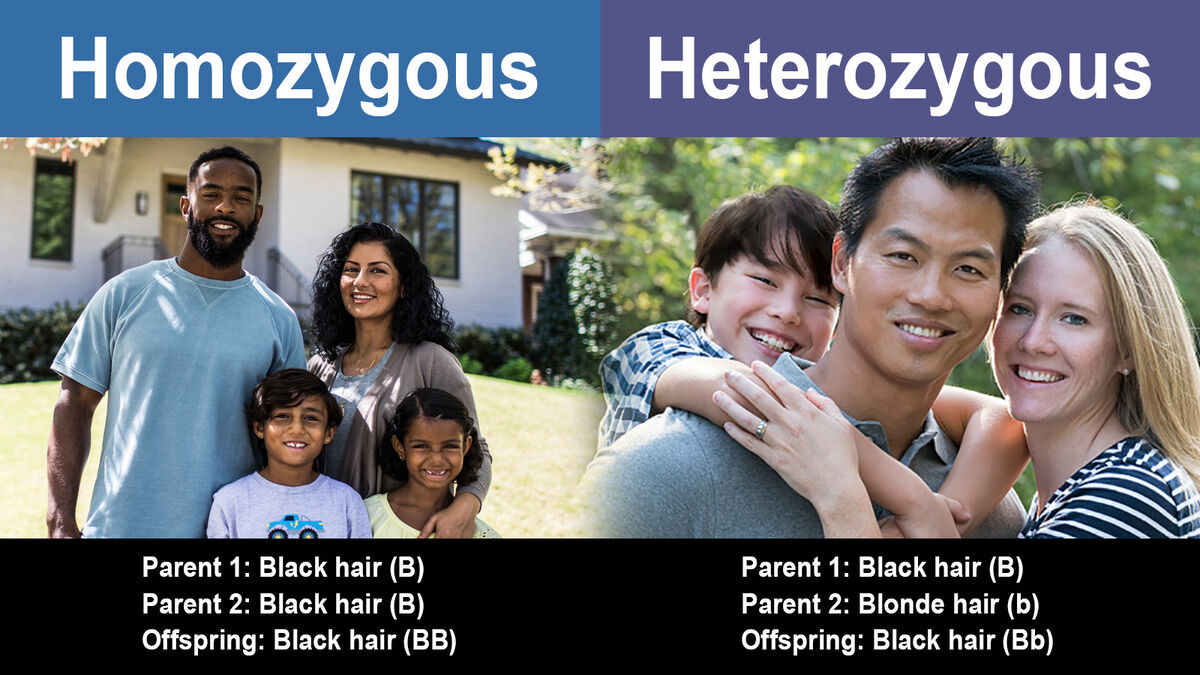
Why do siblings look different even when they have the same parents? The difference lies in their genes – and specifically, whether they have homozygous or heterozygous traits. Keep reading to learn what the difference between these traits are, and what exactly they can determine.
Homozygous and Heterozygous Basics
To understand homozygous and heterozygous traits, you need to know about the basics of genetics and genotypes. All genotypes consist of two alleles – one from the first parent, and one from the second parent. The combination of these alleles determines whether the offspring exhibits homozygous or heterozygous traits.
The difference between these traits is:
- Homozygous traits have two copies of the same allele.
- Heterozygous traits have one dominant allele and one recessive allele.
Whether a trait is homozygous or heterozygous determines how the offspring exhibits that trait. If both parents have a trait, their offspring is more likely to have it as well. However, only a look at the individual’s DNA can determine their likelihood of exhibiting a particular trait.
Examples of Homozygous Traits
Homozygous means “same genes received during the zygote period of development.” An individual with homozygous traits received one copy of each allele from each parent. These alleles can either be dominant or recessive.
You may see homozygous traits in the following situations:
- Both parents have two dominant alleles for black hair (B), so their offspring receive only dominant alleles (BB) and have black hair.
- Parents of a child with recessive type O (oo) blood each have type O blood.
- A litter of purebred Golden Retriever puppies receive the same genes for leg length and fur color from each of their purebred parents.
- Parents who are carriers of genetic mutations on dominant alleles (Dd) have a stronger likelihood of having a child that exhibits a genetic disorder (DD).
- Flowers that each have ten petals create seeds that will sprout flowers with ten petals each.
- Both parents pass on the recessive trait for poor eyesight (e), so the child will also have poor eyesight (ee).
Homozygous traits don’t always mean that offspring look exactly like their parents. However, if a parent has homozygous traits, it’s more likely that their offspring will resemble them. Check out more examples of homozygous traits with an educational article.
Examples of Heterozygous Traits
Genetics get a bit more complicated when it comes to heterozygous, or “different genetic” traits. Offspring who receive a dominant allele from one parent and a recessive allele from the other parent will exhibit heterozygous traits. That’s why siblings with the same parents sometimes look very different from each other: they received different combinations of genes.
Here are some examples of how offspring can exhibit heterozygous traits:
- A parent provides the dominant allele for black hair (B), and the other parent provides the recessive allele for blonde hair (b). The offspring has black hair (Bb) because they exhibit the dominant gene only.
- One parent has two dominant alleles for type A (AA) blood, and the other parent has one dominant allele (B) and one recessive allele (o) for type B (Bo) blood. One child has type AB (AB) blood but their sibling has type A blood (Ao) because they received one dominant A allele and one recessive O allele.
- A litter of puppies with a Golden Retriever mother and a Great Dane father exhibit a variety of traits. Some puppies have shorter legs from their mother’s recessive alleles, while others are very tall because of their father’s dominant alleles.
- One parent is a carrier for a genetic mutation on a dominant allele (Dd), but the other parent only has recessive alleles for that chromosome (dd). The child receives one recessive allele from each parent (dd) and neither carries nor exhibits the genetic disorder.
- Two flowers with ten petals but different genotypes (PP and Pp) produce seeds for flowers with the dominant allele for ten petals and flowers with the recessive allele for nine petals.
- One parent has poor eyesight (ee), but the other has a dominant allele for strong eyesight (Ee). Their offspring range in eyesight ability (ee and Ee).
As you can see, heterozygous traits allow for greater genetic variation. They can also protect offspring from gene mutation and possibly harmful genetic disorders. The alleles that offspring receives from its parents can determine what happens to its genetic line for generations to come.
DNA Is the Key to Life
Life seems so random and unpredictable sometimes. However, understanding the study of genetics helps us understand more about how life works. To learn more about the details of genotypes and genetic traits, read an article that details the occurrence of codominance in genetics. Then, explore some examples of inherited traits.